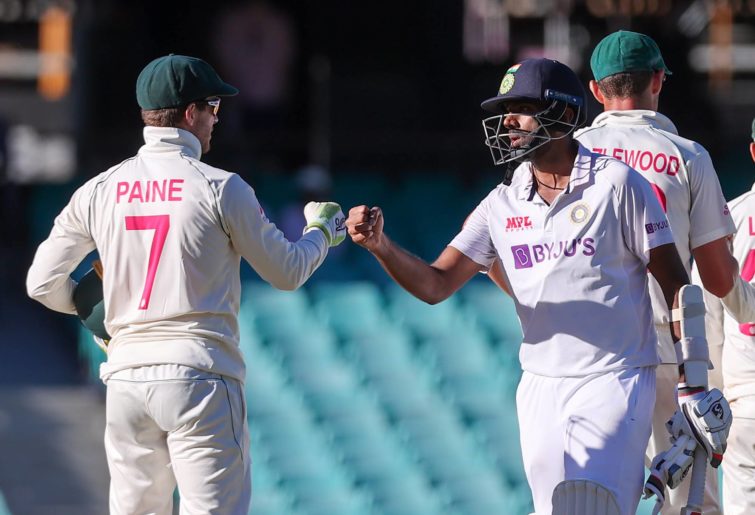World Cup chances up in the air but Smith makes Major call on T20 future, Green dumped despite huge IPL deal
Test great Steve Smith is to play for Washington Freedom in the second season of Major League Cricket as the Australian influence in the…
Opinion
Over the years, the Border-Gavaskar Trophy has had no dearth of extraordinary cricket and riveting drama. But what transpired in Brisbane on 19 January 2021 was in a different realm altogether.
Embattled by injuries and forced to field a greenhorn bowling unit, defending champions India entered the fortress of the Gabba needing at least a draw to maintain their recent stranglehold over the trophy.
Between them, the quintet of Mohammed Siraj, Thangarasu Natarajan, Navdeep Saini, Shardul Thakur and Washington Sundar had played four Tests. On the other hand, Australia were at full strength.
After having been bowled out for 36 in the first Test at Adelaide a month earlier, India had been written off by many. The talismanic Virat Kohli was gone, giving the reins to Ajinkya Rahane.
Rahane led from the front in the Boxing Day Test with a century, underlining that with or without Kohli, this team would be no pushovers.
A fighting draw ensued at Sydney, but by the time the final destination of Brisbane arrived, India were shorn of each of their first-choice frontline bowlers. Australia were smelling blood…
Or so they thought.
“See you at the Gabba,” remarked a cocky Tim Paine to Ravichandran Ashwin from behind the wicket, even as the off-spinner was steering India to safety along with Hanuma Vihari at the SCG.
The Australian captain should have known that he was treading on slippery ground. Yet his team appeared to be in the ascendancy halfway through the deciding contest. Responding to 369, India had been reduced to 6-186.

India’s Ravichandran Ashwin fist bumps with Australia’s captain Tim Paine. (Photo by DAVID GRAY / AFP)
Thakur, playing his second Test, joined Sundar, on debut and playing his first first-class game in three years. The duo brought out the tenacious spirit of the team, putting on a pivotal stand of 123.
With Australia’s lead cut to 33, Siraj, who had debuted at Melbourne and was heckled at Sydney, let the ball do the talking through a haul of 5-73 that made him India’s highest wicket-taker in the series.
Not only were the tourists left staring at a target of 328 on a pitch with uneven bounce, but also at long odds. A total of 300 or more had been successfully chased only 32 times in Test history, India having done it only twice.
Australia had last lost a Test at the Gabba in 1988-89, to a West Indian side boasting stellar names. India had not tasted success in Brisbane in six Tests, though they had come close more than once.
Back in 1967-68, India had lost by 39 runs while chasing 395. Ten years later, they had fallen short by just 16 runs in pursuit of 340. No visiting team had ever chased down more than 200 at the venue.
But this Indian team was unburdened by the baggage of the past. As the final day commenced with anticipation in the air, Shubman Gill, another young debutant in the series, sparkled through the sunshine en route to 91.
With the tone set at one end, Cheteshwar Pujara did what he does best – sap the energy out of the bowlers by laying a platform strong enough to become a launchpad for the risk takers.
In Rishabh Pant, India have a risk taker who can unsettle the best of bowlers in the tensest of scenarios. The spunky wicketkeeper, coming off a typically barnstorming 97 in the chase at Sydney, rose to the task once again.
When Pujara fell for 56, having occupied the crease for 211 balls, India were exactly 100 away.

Cheteshwar Pujara avoids a bouncer from Pat Cummins. (Photo by Patrick HAMILTON / AFP)
When Mayank Agarwal perished, the target had been whittled down to 63 off 80 balls. Sundar, having already exhibited his batting abilities, came out to face the seemingly indefatigable Pat Cummins. With 50 needed in eight overs and Australian shoulders drooping, Pant (89*) and Sundar unleashed the final onslaught.
At Sydney, India shut shop after Pant was dismissed – and rightly so. But at the Gabba, he was there until the end, carting and driving with merriment.
Within a month, Pant had metamorphosed from an uncertainty in the starting XI to the force behind a cathartic, three-wicket win. A good three overs still remained when he charged for the winning four, culminating a most audacious breach of the fortress.
We have seen South Africa chase down 435 in an ODI against Australia at the Wanderers. We have also seen a tied World Cup final at Lord’s. Yet, the magic of a great Test match is something else, as it tantalisingly unfolds like a well-woven canvas delicately revealing its intricacies across five days.
Add to that the situation in which India achieved the improbable and you have the stuff of dreams.
As Rahane went forward to collect the trophy, moments after presenting a memento to Nathan Lyon for his 100th Test in a wonderful gesture, one could finally sense the fairytale sinking in.
India’s victory was a fitting end to a gripping series. It boggled the mind and warmed the cockles of the heart at the same time, and deserves to be talked about as a glorious sporting triumph over adversity for years down the road.